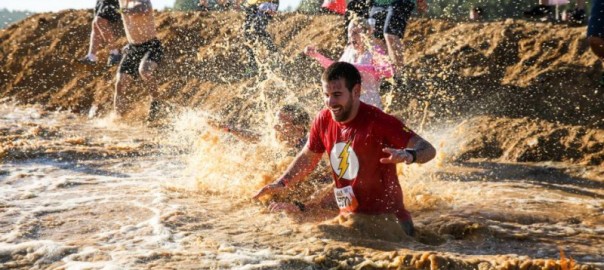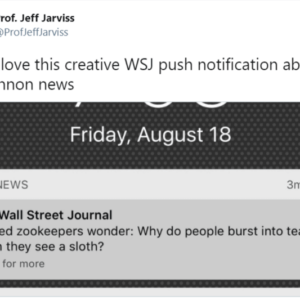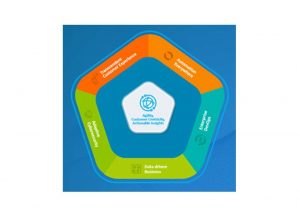Tough Mudder Inc. CMO Jerome Hiquet says his brand relies on video marketing to convey experiences that pictures simply cannot capture.

As CMO of Tough Mudder Inc., Jerome Hiquet knows firsthand how powerful a video can be when you’re leading the charge to recruit participants for one of world’s toughest endurance fitness challenges.
“Tough Mudder is an incredibly visual event,” says Hiquet, “Mudders are using teamwork to get through 10 to 12 miles of mud, ice, fire, and even electric shocks, so while a picture says a thousand words, in our case, that’s not enough; it really takes video to convey that experience.”
This year, Tough Mudder will hit its two-millionth participant, hosting more than 60 events on three continents. Since its start in 2010, the brand has raised over $6,000,000 for the Wounded Warriors Project.
In November of last year, Tough Mudder Inc. named Hiquet CMO, putting him in charge of the brand’s global marketing initiatives for its full line of events, including Tough Mudder, Mudderella, Urban Mudder, Fruit Shoot Mini Mudder and the World’s Toughest Mudder.
Hiquet says his team is split between two functions: advertising and analytics, and branding and creative. While the advertising and analytics team manages paid ad spending and the technical aspects of Tough Mudder’s website and email platforms, the creative team overseas content, copy and visual branding which includes all of Tough Mudder’s video content.
Today, Hiquet tells Marketing Land how his brand is using video content on its site and social channels, along with the results he is seeing with his Facebook and YouTube video marketing efforts.
Tough Mudder CMO Gives the Down and Dirty Details on His Brand’s Video Marketing Strategy

Takeaways:
- Shorter is better than longer, but always keep a close eye on your analytics, and keep learning.
- Each platform merits its own approach. What works on your website might not on Facebook.
- Your team knows your brand and customers best. You can outsource production, but don’t ever outsource creative direction.
Amy Gesenhues: What is your overall goal when it comes to video marketing?
Jerome Hiquet: Our mission is to build a global tribe that lives the values of courage, personal accomplishment, teamwork, and fun. Video content helps us build awareness of the brand, increase consideration to purchase a ticket, and ultimately, inspires people to become Tough Mudders or to keep coming back.
Videos are also great for TMHQ (Tough Mudder Headquarters) team morale. When we send out links, everyone stops what they are doing to check them out. We love what we do here.
Amy Gesenhues: How does video marketing fit into your overall digital marketing efforts?
Jerome Hiquet: We use video across the entire marketing funnel, both to introduce the event to people who have never heard of it (for example, through pre-roll ads on YouTube), then as a mid-funnel entertainment device to energize and inspire our five million-plus global Facebook community, and finally as a bottom-funnel tool on our website to highlight our innovative obstacles and showcase inspirational participant stories.
Amy Gesenhues: What types of video content do you most often post?
Jerome Hiquet: In the past we’ve primarily done high-action event recap videos, but in 2014, we shifted our focus to first, our innovative new obstacles, and second, stories of inspirational participants.
For example, in 2014 we created Fire In Your Hole, a cargo net climb to a 25’ slide, the bottom portion of which has the Mudder flying through a wall of 5-foot gas flames.
We also did a series of stories called “Overcome All Obstacles” including one of a former U.S. Marine with Leukemia who has done 25 Tough Mudders. Our community is really amazing.
Amy Gesenhues: How much user generated content do you use versus videos created by your team?
Jerome Hiquet: While most of the content we distribute is content we’ve made, we know we also benefit enormously from user generated training and event videos, many of which are filmed on GoPro cameras.
Our social media team is always following our community and looking to repost the best content. Not to say it’s always easy, given that many videos include some “choice” words as Mudders jump into the Arctic Enema (ice bath) obstacle. We have to use the “bleep” function in those cases.
Our main rule is that we won’t share anything that uses our course or obstacles in a way they aren’t intended to be used. Safety is our company’s #1 priority, and we’ve actually created a video specifically to describe how we build that into everything we do.
Amy Gesenhues: What is the average length of your videos and how often do you post them?
Jerome Hiquet: During a normal month, we’ll upload about six to eight videos to Facebook. We want to make sure that we put out really engaging content, so while we could, we try not to post every day.
Over time we’ve been getting shorter and shorter. These days our average videos are under the two-minute mark, although it does vary. On Easter last year we published a video of a man in a bunny costume going down the Fire In Your Hole obstacle (we said we “put fire in the Easter Bunny’s bum”).
On the other hand, we’ve done a 15-minute documentary of our 24-hour non-stop event called World’s Toughest Mudder. This month we are releasing a 5-part mini-documentary series called “Obstacles ReDefined” about our internal obstacle innovation team. It’s pretty eye-opening.
Amy Gesenhues: Which social channels do you use to share your videos?
Jerome Hiquet: Right now the main channels are Facebook, where we have five million-plus followers, YouTube, where we’ve had over 30 million views, and our website, which currently receives nearly two million unique views each month.
We also use Instagram on occasion (although we generally consider that mostly a photo site) and we are exploring new platforms like Snapchat.
Amy Gesenhues: Can you share engagement rates on the videos you have posted and/or uploaded to Facebook?
Jerome Hiquet: When we post a video on Facebook, we regularly see over one-million views, with 30 percent of those being for 30-seconds or more.
We have very high YouTube engagement rates as well, with on average viewers staying with our videos for 50 percent to 60 percent of their duration, and we have high rates of cyclical viewership meaning folks are clicking on another video immediately after watching the previous.
Amy Gesenhues: How do your Facebook engagement rates compare to your engagement on YouTube?
Jerome Hiquet: Right now for us, Facebook gives us better distribution. By contrast, YouTube is a great platform to power video views on our website.
We have 40,000 subscribers on YouTube but we know we need to do a better job in 2015 of building up that channel.
Increasingly brands need to have specific content strategies for each channel, and on YouTube we know we need to develop more serialized or personality-driven content to drive a more defined reason to subscribe and follow.
Amy Gesenhues: Has your Facebook video efforts changed at all over the past year?
Jerome Hiquet: Over the past year, we’ve begun to distribute videos through Facebook using the native Facebook player. This is a bit more work than just using a YouTube link, but the way the video appears in the news feed is much better, and it boosts engagement.
We’re excited to see the new tools that Facebook will develop for brands like us to manage our video content on their platform.
Amy Gesenhues: How do you see video marketing evolving in the coming year?
Jerome Hiquet: Video content is increasingly becoming the dominant form by which brands communicate to their audiences. Audiences, you ask? Yes: brands in 2015 no longer have customers, they have communities, followers, and subscribers.
Interruption marketing will continue to diminish in favor of creating great content that people want to watch, engage with, and share with their networks.
Brands in 2015 need to develop coordinated multi-platform marketing campaigns (of which video will play a large part, but not be the only part) optimized for each channel (Facebook, YouTube, Instagram, Website, PR). This presumes of course that brands have something to say, either about their new products or their incredible customers. In Tough Mudder’s case, that’s not an issue.
Marketing Land – Internet Marketing News, Strategies & Tips
(396)
Report Post










